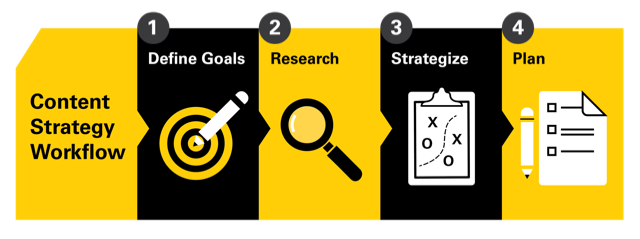We can all agree that we live in a digital age. And while the constant innovation of new technology and ways of communicating information can be an advantage to growing your business, it can also be easy to feel like you’re falling behind the competition. But don’t worry, staying on top of your business is easier than you think, and it comes down to one thing – digital marketing.
Digital marketing not only helps keep your business connected with current consumers, but it can also expand your new business list. The big question is, “How do I get started and how can I utilize digital marketing to stay ahead of the competition?”
The answer is simple: content strategy.
Content strategy is essentially the way your business manages its content, ensuring that it is both user-focused and goal-oriented. Digital content, which can be anything from blogs, videos, white papers, social media posts and the like, can be shared in a multitude of ways. Ultimately, however, its job is to communicate who your business is and why consumers should choose you over your competitors. By developing relevant and engaging content, your customers can find answers to their questions without feeling like they are just another target for you to sell to.
To help you get started, here are a few steps to assist you in creating the best content strategy for your business:
1. Define Your Goals
- What do you want to accomplish?
- Are you interested in driving more overall traffic to your site?
- Are you looking to increase the sales and revenue for a specific product this quarter?
- Do you want to grow customer engagement online?
Whatever it may be, a strategy is not complete without goals. Once you have defined the goals, establish KPIs (key performance indicators) so you can measure your efforts and determine the effectiveness of your strategy in relation to those goals. These KPIs are 100 percent your call. Whether you want to measure the amount of traffic your site obtains organically in a certain period of time, or the amount of engagement you have gained through social media, all that matters is that you establish these items so you have measurable results to reflect on when moving forward.
2. Conduct Audience Research
Getting to know your target audience is crucial to not only delivering the right message, but also for delivering the right message to the right audience at the right time. Do not assume you know who is reading your content. Do your research so that your messaging is as strategic and effective as possible. If you’re unsure of where to start, there are several great resources right at your fingertips! Check out
this quick six minute read to get started.
3. Create Key Differentiators/Messaging Strategies
You know that your content needs a purpose and it needs to cater to its audience. However, another key factor in content strategy is giving your content a unique angle or something that makes it stand out. What is it about your business that makes you stand out against competitors? Find gaps in what the industry is serving its consumers and use those gaps as an opportunity to create content that really shines and drives business.
4. Develop Your Content Plan
You are now ready to develop a full content plan. You have already conducted research to determine the type of audience you want to target and reach. You have discovered the key differentiators that will set you apart from competitors and a unique message to deliver. Now all you have to do is determine the types of content you want to create (i.e. blog posts, case studies, social media posts, etc.) and you’ll be well on your way to fulfilling your strategy.

Congratulations! You have read through all the steps and are now ready to create and manage your content. Two helpful tools to do just that are editorial calendars and content workflow.
What are Editorial Calendars?
Creating an editorial calendar is a great way to stay organized during both the planning process as well as the implementation process. It will not only allow you to schedule content for certain platforms or channels, but it will also help you manage your resources and team. You can create one for free with your Google account on Google Calendar, use
Hubspot’s free template or decide to invest in a platform, such as
Kapost. Simply do your research and decide which platform will be most beneficial for you.
What is a Content Workflow?
Developing a content workflow is also a crucial step as it incorporates not only creating, publishing and distributing (via social media posts, publishing the content on your website, etc.) your content, but also assigns responsibilities to specific team members. It allows your business to stay as effective and organized as the content you have worked so hard to create.
If you’re still feeling a little lost, you’re not alone. Sixty percent of B2B marketers say they struggle to come up with engaging content for their audience ("
Simple Ways to Use Digital Marketing to Grow Your Business"). The good news is, once you master the content you can reuse it across other channels simply by altering the messaging and structure to match that channel.
For more tips and guidance on how to create your own content strategy, download
Simple Ways to Use Digital Marketing to Grow Your Business.